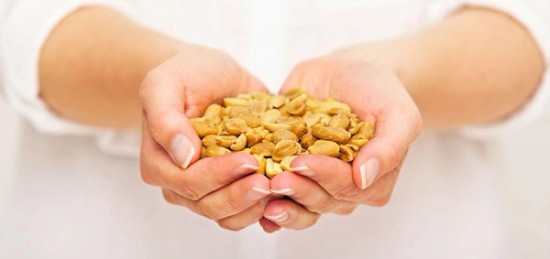By Caroline Young, MS, RD, LD, RYT
Strokes cause one out of every 20 deaths in America [i]. In a systematic review of 20 studies, grabbing a daily handful of peanuts was associated with a decreased stroke risk [ii]. Plus, the analysis, published in the journal BMC Medicine, looked at studies linking both nut and peanut intake with other diseases like coronary heart disease (CHD) and cardiovascular disease (CVD), as well as mortality.
The Nitty Gritty
CHD and CVD disease risk reduction was associated with nut and peanut intake when people ate a handful, defined as 15 to 20 grams, or about 20 nuts, five to six servings per week.
Specifically, 11 of the studies looked at peanut and nut intake and stroke and included more than 396,000 people in the U.S., Europe and Asia. Of those studies, peanuts were the only nuts to which researchers found a statistically significant association between high and low consumption levels and decreased stroke risk.
In the analysis, all studies were prospective cohort studies, meaning they were observations of disease outcomes in more than 800,000 people — primarily adults in the U.S. and Europe — over given periods of time.
In other words, there were no direct interventions, and instead, the studies looked at data over a period of time and included people who were choosing their diets and may have also been engaging in other healthful activities. Also, the studies may have had people who were falsely reporting the amount and weight of peanuts and nuts they ate daily. There were also some differences in study populations. For example, while most studies included both genders, three included men only and five included women only.
‘Nut’rition and Disease
Nuts and peanuts are solid sources of several nutrients, including fiber. In fact, an ounce of peanuts (about 28 nuts) gives you 10% of the recommended daily intake. One modifiable risk factor for stroke is high cholesterol, and fiber plays a role in helping maintain normal circulating cholesterol levels [iii].
Another modifiable risk factor of stroke is obesity, and eating more fiber can also aid in maintaining a healthy weight, by adding bulk and filling you up [iv].
Fiber has been associated with a decreased stroke risk in another analysis of eight studies. Researchers found an increase of 7 grams of fiber per day, which you can get in one snack, was associated with reduced stroke risk [v]. Grab an apple, which has an average of 4 to 4 ½ grams of fiber, according to the USDA, and an ounce of peanuts, which has 2.4 grams of fiber, per the USDA, and you’re good to go.
Association vs. Cause: What’s the diff?
“Eat peanuts and you won’t have a stroke” sounds like an easy-to-follow rule — almost too good to be true — probably because it is, based on this analysis. Given the fact that no randomized controlled trials (RCTs) — the gold standard in research— were included, a cause-and-effect relationship between nut and peanut consumption, and disease risk was not revealed.
According to the Dietary Guidelines for Americans, eating 5 ounces of nuts (including peanuts) on a weekly basis is recommended, and they should be included in a balanced diet as a source of plant-based protein, good fats and fiber [vi].
To delve deeper into the research around peanuts and stroke, click here.
To delve deeper into the research around peanuts and heart health, click here.
References
[i] Stroke Statistics and Maps. Centers for Disease Control and Prevention. https://www.cdc.gov/stroke/statistics_maps.htm. Published 2015. Accessed December 15, 2016.
[ii] Aune, D., Keum, N., Giovannucci, E., Fadnes, L. T., Boffetta, P., Greenwood, D. C., Tonstad, S., Vatten, L. J., Riboli, E., & Norat, T. (2016). Nut consumption and risk of cardiovascular disease, total cancer, all-cause and cause-specific mortality: a systematic review and dose-response meta-analysis of prospective studies. BMC medicine, 14(1), 207. https://doi.org/10.1186/s12916-016-0730-3
[iii] Dahl W, Stewart M. Position of the Academy of Nutrition and Dietetics: Health Implications of Dietary Fiber. J Acad Nutr Diet. 2015;115(11) 1861-1869. https://www.jandonline.org/article/S2212-2672(15)01386-6/fulltext.
[iv] Eat More, Weigh Less? Centers for Disease Control and Prevention. https://www.cdc.gov/healthyweight/healthy_eating/energy_density.html. Published 2015. Accessed December 15, 2016.
[v] Threapleton D, et al. Dietary Fiber Intake and Risk of First Stroke. Stroke. 2013; 44:1360-1368. Doi: https://doi.org/10.1161/STROKEAHA.111.000151.
[vi] Chapter 1 Key Elements of Healthy Eating Patterns. A Closer Look Inside Healthy Eating Patterns - 2015-2020 Dietary Guidelines. https://health.gov/sites/default/files/2019-09/2015-2020_Dietary_Guidelines.pdf. Accessed January 31, 2017.
